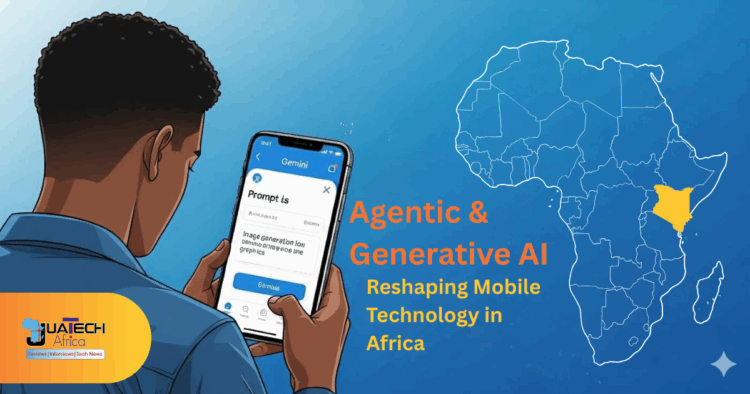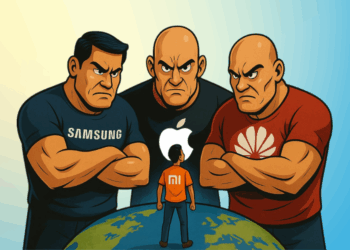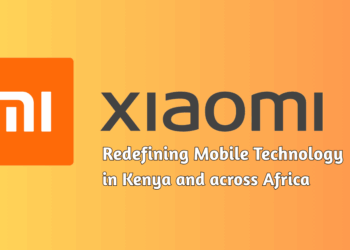Why Agentic and Generative AI Matter for Kenyan and East African Smartphone Users
In East Africa, where smartphones are lifelines and mobile-first innovation is the norm, the rise of intelligent devices powered by agentic and generative AI carries unique implications. This article examines how these technologies intersect with affordability, language, infrastructure, and opportunity — and why Africa must shape its own narrative of mobile intelligence.
1. The Smartphone’s Second Awakening
In the last decade, the smartphone has evolved from a pocket-sized convenience into a digital cornerstone of modern life. However, today a more profound metamorphosis is underway — one that transcends hardware specifications and app ecosystems. We are entering an era where smartphones are no longer merely smart. They are becoming intelligent, autonomous, and creative. Two converging forces: agentic AI, which enables devices to act on behalf of users, and generative AI, which empowers them to produce content, context, and insight with startling fluency power this shift.
This isn’t just a technological upgrade — it’s a paradigm shift. Agentic AI transforms your phone into a proactive collaborator, anticipating needs, making decisions, and executing tasks with minimal input. Generative AI, meanwhile, turns it into a creative engine — capable of summarizing documents, translating languages, generating images, and even composing messages that sound like you. Together, they redefine what it means to interact with mobile technology.
Yet amid this global acceleration, a critical question emerges: What does this revolution mean for the Kenyan and East African smartphone user? In a region where mobile penetration exceeds 100%, but affordability, infrastructure, and linguistic diversity remain complex realities, the implications of smartphones are both exhilarating and nuanced.
This article unpacks the anatomy of this transformation — demystifying the technologies, exposing the gaps in global narratives, and illuminating the opportunities for African-first innovation. Whether you’re a developer in Nairobi, a digital entrepreneur in Kisumu, or a curious student in Eldoret, the future of mobile intelligence is knocking. And it’s not just smart — it’s agentic, generative, and deeply rooted in African culture.
2. Agentic vs. Generative AI: What They Are and Why They Matter
Defining the Pillars of Intelligent Technology
To grasp the gravity of this shift, we must first define its foundations. Agentic AI refers to artificial intelligence that exhibits autonomy and self-determination. It doesn’t just respond — it acts. It learns your routines, anticipates your needs, and initiates tasks without explicit commands. Think of Google Assistant suggesting you leave early for a meeting based on traffic, or Samsung’s Galaxy AI optimizing battery usage based on your habits. Agentic AI is the proactive brain behind your device — a silent strategist working in the background.
Generative AI, on the other hand, is the creative engine. It produces content — from text and images to summaries and translations — based on prompts or context. It powers features like Google’s Magic Compose, which rewrites your messages in different tones, or Samsung’s Generative Edit, which lets you manipulate photos using natural language.
Doing vs. Creating: A Subtle but Powerful Divide
The distinction is subtle but profound.
- Agentic AI is about doing — making decisions, taking action.
- Generative AI is about creating — producing new outputs from existing data.
When fused into smartphones, these capabilities unlock a new paradigm: devices that not only understand you, but also express, adapt, and evolve with you. They become extensions of your cognition — not just tools, but partners.
Why It Matters in Mobile-First Africa
In mobile-first regions like East Africa, where smartphones are often the primary — or only — computing device, this fusion carries immense potential.
- Personalized learning
- Localized content creation
- Intelligent automation for daily life
But for this promise to be realized, it must be contextualized, localized, and democratized. That means building models that reflect African languages, cultures, and connectivity realities — not just importing global defaults.
This is not just a tech evolution. It’s a cognitive revolution — and Africa must shape it from the ground up.
3. Global Trends: Flagship Devices Leading the Charge
Globally, the race to embed agentic and generative AI into smartphones is accelerating — and flagship devices are setting the pace.
Samsung’s Galaxy S25 Ultra, for instance, features Circle to Search, allowing users to draw a circle around any object on screen to retrieve contextual information instantly. Its Live Translate enables real-time voice translation during calls, while Generative Edit lets users manipulate photos with simple voice or text commands.
Google’s Pixel 10 Pro XL integrates Gemini Nano, an on-device generative model that powers smart replies, summarization, and context-aware suggestions — all without sending data to the cloud. This marks a shift toward edge AI, where intelligence resides on the device itself, preserving privacy and reducing latency.
Apple’s iPhone 16 Pro Max is rumored to integrate generative capabilities into Siri, enabling more fluid conversations, proactive task execution, and AI-enhanced workflows across iOS.
These features are not just novelties — they’re signals of a more profound shift. Smartphones are becoming agentic collaborators and generative creators, capable of navigating context, crafting content, and executing decisions.
However, here’s the catch: these innovations are primarily confined to premium devices. The question for Africa is not just what’s possible, but what’s accessible.
Can mid-range phones deliver similar intelligence?
Is there possibility for telcos and OEMs democratize these capabilities?
Can local developers build African-first AI experiences?
The global wave is undeniable. But the regional tide must be shaped intentionally.
Flagship vs. Mid-Range AI Smartphones in 2025
| Feature | Galaxy S25 Ultra | Pixel 10 Pro XL | Tecno Phantom V Flip | Xiaomi Redmi Note 13 Pro | Realme 12 Pro+ |
| Agentic AI | Battery optimization, proactive alerts | Context-aware replies | Smart charging assistant | Scene-based camera automation | Smart call filtering |
| Generative AI | Photo editing, voice translation | On-device summarization | AI-generated wallpapers | Text-to-image filters | Magic text composer |
| On-device AI | Partial | Full (Gemini Nano) | Limited | Partial | Partial |
| Price Range | Premium | Premium | Mid-range | Mid-range | Mid-range |
This table helps readers visualize the AI landscape across price points — reinforcing your buyer guide strategy from JuaTech Africa’s Ultimate Smartphone Buying Guide Kenya 2025.
4. Why Agentic and Generative AI Matter for Kenyan and East African Users
Smartphones as Lifelines, Not Luxuries
In Kenya and across East Africa, the smartphone is far more than a gadget — it is a digital lifeline, a gateway to commerce, education, and civic engagement. With mobile penetration surpassing 129% and Android accounting for over 85% of the market share, the region is well-positioned for intelligent mobile experiences. Nevertheless, beneath this promising surface lie layered realities that demand deliberate innovation.
Constraints That Shape Opportunity
To begin with, the majority of users operate on prepaid data plans, which inherently limit access to cloud-based AI services. Additionally, most devices in circulation are mid-range or entry-level, often limited by their constrained RAM, storage, and processing power. Compounding this is the region’s linguistic diversity — from Swahili and Sheng to Luhya, Kikuyu, and Somali — which global AI models often fail to accommodate with nuance or accuracy.
Consequently, the promise of agentic and generative AI must be reimagined through a regional lens. It is not enough to import intelligence; it must be localized, optimized, and democratized.
Real-World Scenarios That Demand Local Intelligence
Consider a boda boda rider in Nairobi, whose smartphone proactively suggests alternate routes based on traffic density and fuel efficiency — powered by agentic AI trained on local mobility patterns. Or a small business owner in Kisumu, using generative AI to craft Swahili marketing posts that reflect regional idioms and cultural tone. Or a student in Eldoret, summarizing lecture notes offline, without consuming data — thanks to edge-based generative models.
These are not speculative dreams. They are achievable realities, provided AI is designed with intentional regional context.
The Role of Telcos, OEMs, and Developers
Telcos like Safaricom and Airtel could catalyze this shift by bundling AI features into affordable data plans, optimizing for low-bandwidth environments, and supporting on-device intelligence. Meanwhile, OEMs such as Tecno, Infinix, and Xiaomi must prioritize the development of AI-ready mid-range devices. Equally, local developers must rise to the challenge — building Swahili-first voice assistants, offline summarizers, and AI-powered civic apps that reflect East African realities.
A Call for Intentionality
Ultimately, the opportunity is immense — but it demands intentionality. Agentic and generative AI must be localized, affordable, and inclusive. Otherwise, the smartphone’s second awakening will remain a privilege of the few, rather than a transformative leap for the many.
5. What Global AI Coverage Misses — And Why East Africa Needs Its Own Lens
The Illusion of Universality
Global tech media often frames AI as a sweeping, borderless revolution. Yet, beneath the surface, the reality is far more complex and fragmented. Coverage tends to focus on flagship devices, cloud-dependent models, and Western-centric use cases — rarely examining how these technologies are received in regions with limited connectivity, linguistic complexity, and economic constraints.
This oversight is not benign. It creates a narrative vacuum, where African realities are either misrepresented or ignored entirely.
Blind Spots That Undermine Inclusion
There’s little meaningful discourse around:
- Swahili voice assistants that understand tonal nuance and regional slang
- Offline-first generative tools that function without constant data access
- AI systems trained to reflect local idioms, civic needs, and cultural norms
These gaps matter. Because what’s dismissed as niche in Silicon Valley may be transformative in Nairobi, Kampala, or Dar es Salaam.
From Access to Agency
East Africa doesn’t merely need access to AI — it needs agency in shaping it. That means:
- Building local datasets that reflect linguistic and behavioral diversity
- Training regionally relevant models optimized for mobile-first realities
- Designing UX frameworks that thrive in low-bandwidth environments
It also means challenging the myth of “universal AI.” Intelligence is contextual. A model that excels in San Francisco may falter in Nakuru. And a feature deemed minor globally — like Swahili summarization — could unlock massive utility locally.
The Role of African Platforms
Platforms like JuaTech Africa are uniquely positioned to fill this void — translating global trends into regionally grounded narratives, spotlighting African-first use cases, and empowering users to lead, not just follow.
By anchoring AI discourse in East African realities, we don’t just catch up — we redefine what intelligent technology looks like when it’s truly inclusive.
5. Real-World Applications and the Builders Behind Them: Agentic & Generative AI in Action
From Gaps to Groundbreakers
As established in Part V, global AI coverage often overlooks the nuanced needs of users in East Africa. However, while the narrative gap persists, the region’s developer ecosystem is quietly—and powerfully—rewriting the script. From Nairobi’s innovation hubs to pan-African coding communities, a new generation of builders is crafting agentic and generative AI solutions that reflect local realities, linguistic diversity, and mobile-first constraints.
These developers aren’t just responding to global trends — they’re redefining them.
Everyday Scenarios, Reimagined Through Local Intelligence
- A Nairobi commuter receives proactive alerts about matatu delays, fuel-saving routes, and weather disruptions — powered by agentic AI trained on local mobility data.
- A Kisumu entrepreneur uses generative AI to craft Swahili product descriptions, promotional flyers, and social captions — tailored to her brand voice and regional idioms.
- A Mombasa teacher leverages AI to translate lesson plans into multiple dialects, generate quizzes, and summarize student feedback — all offline.
- A law student at Moi University in Eldoret uses edge-based summarization to condense lecture recordings into bullet points and flashcards — without consuming data.
These aren’t hypothetical. They’re prototypes waiting to scale — and local developers are already laying the groundwork.
Developer Ecosystem Spotlight: Builders of the African AI Renaissance
- Lelapa AI, based in South Africa, is training African language models that understand Swahili, isiXhosa, and other indigenous languages — with ethical design baked in.
- Fastagger, headquartered in Nairobi, offers AI-powered data labeling for African datasets — enabling precision training for localized models.
- AI Kenya and Data Science Africa host hackathons, workshops, and open-source collaborations that empower developers to build civic apps, voice assistants, and generative tools tailored to East African realities.
- Zindi Africa, a pan-African data science platform, connects thousands of AI practitioners to real-world challenges — from agriculture forecasting to fintech fraud detection.
These ecosystems are more than technical communities — they’re economic engines. By building regionally relevant AI, they unlock new monetization streams:
- Freemium civic apps
- Localized SaaS platforms
- AI-powered consulting for SMEs and NGOs
The financial upside is clear. But the deeper value lies in agency — in Africans designing the intelligence that will shape their digital futures.
7. Ethics, Regulation, and the Elephant in the Room: Rethinking AI Governance in Kenya and E. Africa
The Law That Led — But Didn’t Anticipate AI
Kenya’s Data Protection Act (2019) was a landmark move. It defined how personal data should be collected, stored, and processed — covering breach notifications, user rights, and the obligations of data controllers. But it wasn’t built for the age of agentic and generative AI. These technologies introduce new risks that stretch beyond the law’s original scope.
Where Does Your Data Go — And Who Owns It?
When your phone summarizes emails or translates your voice, that data often travels to foreign cloud servers, with most generative models hosted outside Africa. As a result, Kenyan users risk losing control over their digital footprint. This is a data sovereignty issue, and it’s not theoretical — it’s happening now.
Consent Without Clarity
Agentic AI can act on your behalf — filtering calls, booking appointments, or replying to messages. But did you explicitly authorize those actions? Kenya’s law requires “informed consent,” yet most users are clicking through vague pop-ups without understanding what they’re agreeing to.
Immaculate Kassait, Kenya’s Data Commissioner, made it clear at the Connected Summit 2024 in Diani:
“AI must not outpace accountability. Consent must be contextual, not just contractual.”
(Source: Communications Authority of Kenya, April 2024)
Language Bias and Cultural Blind Spots
Generative models trained on Western data often misrepresent African dialects, idioms, and civic norms. This isn’t just a technical flaw — it’s a cultural erasure. UNESCO’s Ethics of AI (2021) framework emphasizes the importance of linguistic inclusion. Kenya’s National AI Strategy 2025–2030 echoes this, calling for Swahili-first models and community-led datasets.
Global Standards, Local Realities
International frameworks, such as the EU’s GDPR and OECD AI Principles, emphasize transparency, user control, and data localization. Kenya must adapt these principles to fit its mobile-first, prepaid-data environment. That means exploring edge-based AI, federated learning, and locally hosted models — not just relying on foreign infrastructure.
The Path Forward: Digital Dignity by Design
Ethical AI in Kenya isn’t just about compliance — it’s about digital dignity. Regulators must evolve. Developers must localize. And users must be empowered to question, opt out, and shape the intelligence they interact with.
This isn’t a future problem. It’s a present challenge — and Kenya has the chance to lead. Let’s not miss it.
8. The Future: Smartphones as Co-Pilots in African Innovation
From Tools to Teammates
Africa’s mobile journey has been defined by ingenuity. From M-PESA’s launch in 2007 to today’s smartphone-driven ecosystems, the continent has consistently turned limitations into breakthroughs. With mobile penetration at 129% in Kenya and over 650 million smartphone users across Africa, the device in your hand is no longer just a tool — it’s a gateway to transformation.
Now, a new frontier is emerging.
Agentic and Generative AI: The Next Leap
Imagine a smartphone that doesn’t just respond — it collaborates. It negotiates airtime bundles based on your habits. A handset that drafts business proposals in your voice. One that translates civic documents into your dialect. It becomes a co-pilot — not just in productivity, but in life.
This is the promise of agentic and generative AI. And Africa is uniquely positioned to lead. With a mobile-first infrastructure, a young and dynamic developer base, and a culture of adaptive innovation, the continent can leapfrog traditional tech models.
Intentional Innovation Is Non-Negotiable
Leadership won’t happen by accident.
- Developers must build regionally trained models that reflect African languages and realities.
- Educators must embed AI literacy into classrooms and community programs.
- Telcos must support on-device intelligence and offline-first solutions.
- Policymakers must craft rights-based frameworks that protect users and enable growth.
Claiming the Narrative
Platforms like JuaTech Africa, if properly involved, can catalyze this movement — translating global trends into local relevance, spotlighting African-first use cases, and building a community of builders, thinkers, and users who see AI as a native tool for empowerment.
The question isn’t whether AI will reshape mobile technology. It’s who will shape that reshaping — and how.
Africa has the numbers. It has the talent. Now, it must lead.
Conclusion: Reimagining the Device in Your Pocket
Africa’s Intelligence Isn’t Artificial — It’s Intentional
The smartphone is no longer just a device. It’s a gateway to agency, creativity, and transformation. In Africa, where mobile technology is deeply embedded in daily life, its evolution holds profound potential.
We’ve explored the gaps in global AI narratives, spotlighted local innovation, and challenged assumptions. But this isn’t just a conversation about tech. It’s a conversation about ownership, identity, and direction.
If you’re a developer, build with context. For policymakers, regupolicymakerslate with foresight. If you’re a user, demand clarity, dignity, and relevance.
The future of mobile intelligence in Africa won’t be imported. It will be imagined, coded, and led from within.
It’s not just smart. It’s agentic, generative, and deeply rooted in African culture. And it’s already in your pocket.
Your Voice Matters
This article is a starting point — not a final word. Comment. Critique. Share. Ask. Build. Let’s shape the future of AI together, from the ground up.
JuaTech Africa is listening. The continent is watching. And the world is waiting.
















